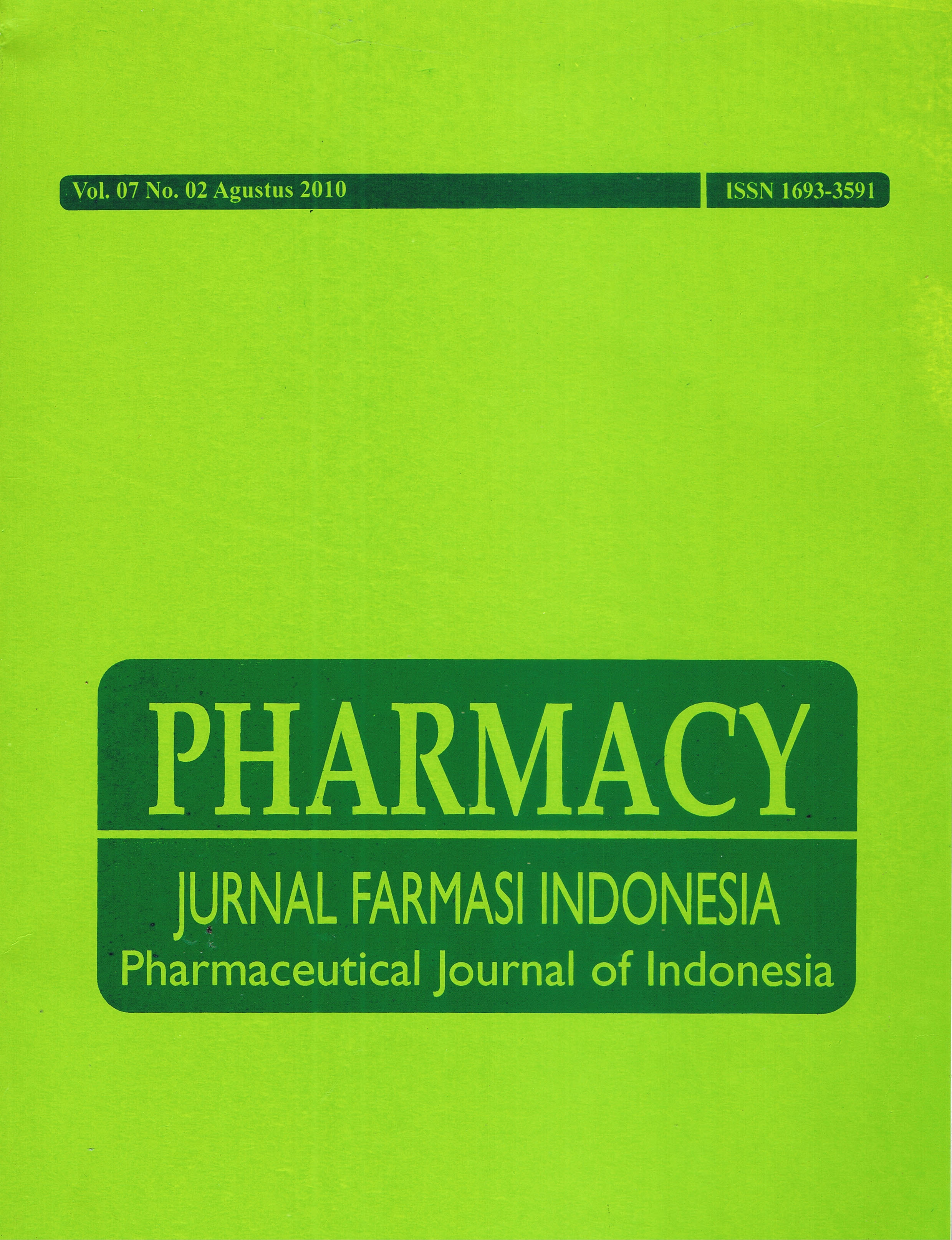EFEK ANTIANGIOGENESIS FRAKSI VI dan VII EKSTRAK METANOLIK KAYU SECANG (Cesalpinea sappan L.)
DOI:
https://doi.org/10.30595/pji.v7i1.560Abstract
ABSTRAK Penghambatan proses angiogenesis merupakan salah satu strategi menghambat perkembangan kanker. Penelitian ini bertujuan untuk mengetahui efek antiangiogenesis fraksi VI dan VII ekstrak metanolik kayu secang (Caesalpinia sappan L.) menggunakan model pembuluh darah pada mata tikus. Mata tikus diberi perlakuan bFGF (induktor angiogenesis) dan ekstrak metanolik kayu secang selama 8 hari selanjutnya diamati respon angiogenesisnya. Berdasarkan penelitian yang dilakukan didapatkan hasil ekstrak metanolik kayu secang mampu menghambat angiogenesis pada mata tikus. Respon angiogenesis untuk fraksi VI dosis 200, 400 µg/mL dan fraksi VII dosis 500, 1000 µg/mL masing-masing secara berurutan adalah sebesar (dalam %) 5 ± 7,07; 0 ± 0; 6,25 ± 8,83; 8,33 ± 0. Hasil ini menunjukkan bahwa fraksi VI dan VII ekstrak metanolik kayu secang memiliki efek antiangiogenesis. Kata kunci: antiangiogenesis, mata tikus, Caesalpinia sappan L. ABSTRACT Inhibition of angiogenesis has become a strategy to inhibit cancer development. The aim of the research is to investigate antiangiogenesis effect of 6th and 7th fractions of secang wood methanol extract (Caesalpinia sappan L.) in situ using rat eyes. Rat eyes were treated with b-FGF (angiogenesis inductor) and extracts during eight days to observe its angiogenesis response. The results showed that the secang wood methanol extracts could inhibit angiogenesis in rat eyes. Doses 200, 400 µg/mL of 6th fraction and doses 500, 1000 µg/mL of 7th fraction gave angiogenesis response of (in percent) 5 ± 7.07; 0 ± 0; 6.25 ± 8.83; 8.33 ± 0, respectively. These results indicate that the fractions have antiangiogenic effect. Key words: antiangiogenic, rat eyes, Caesalpinia sappan L.References
Badami, S., Moorkoth, S., Rai, S. R., Kannan, E., Bhojraj, S., 2003, Antioxidant activity of Caesalpinia sappan heartwood, Biol. Pharm. Bull, 26(11): 1534-1537.
DePadua, L.S., N. Bunyapraphatsara and R.H.M.J. Lemmens. 1999. Plants Resources of South-East Asia, Bogor, Indonesia.
Ermawati, Dian. 2004. Efek Penghambatan Angiogenik Ekstrak Etanol Daun Gynura procumbens (Lour.) Merr. Pada Mata Tikus Rattus nurvegicus SD terinduksi b-FGF. Yogyakarta: Universitas Gadjah Mada.
Jenie, R.I., Meiyanto, E., Murwanti, R., 2006. Efek antiangiogenik ekstrak etanolik daun sambung nyawa (Gynura procumbens (Lour.) Merr.) pada membran korio alantois (CAM) embrio ayam. Majalah Farmasi Indonesia 17(1), 50 – 55, 2006
Kerbel, R., and Folkman, J., 2002, Clinical Translation of Angiogenesis Inhibitors, Nat. Rev., 2: 727-739.
Keshet, E., and Ben-Sasson, S. A., 1999, Anticancer drug targets:approaching angiogenesis, J. Clin.
King, R.J.B., 2000, Cancer Biology, Ed. 2, Pearson Education, England
Lee JS, Kim JH, Kim YG. 2007. Anticancer effects of caesalpinia sappan extracts on oral carcinoma and osteosarcoma cells. J Korean Assoc Oral Maxillofac Surg. 2007 Dec;33(6):583-590. Korean.
Li et al. 2009. Understanding angiogenesis. The Angiogenesis Foundation. http://www.angio.org/understanding/understanding.html. Diakses pada bulan Februari 2009
Daly, ME., Andreas Makris, Malcolm Reed, Claire E. Lewis. Hemostatic Regulators of Tumor Angiogenesis: A Source of Antiangiogenic Agents for Cancer Treatment. Journal of the National cancer Institute, Vol. 95, No. 22, 1660-1673, November 19, 2003
Masferrer, J.L, and Leahy K.M, et al, 2000, Antiangiogenic and Antitumor Activities of Cyclooxygenase-2 Inhibitors, Cancer Res, 60:1306-1311.
Morabito, A., De Maio, E. et al. Tyrosine kinase inhibitors of vascular endothelial growth factor receptors in clinical trials: current status and future directions. Oncologist. 2006;11:753-764
Nurulita, N.A., 2005, Efek Sitotoksik dan Anti Proliferasi Ekstrak Metanol Kayu Secang (Caesalpinea sappan L.) terhadap sel kanker payudara T47D.
Ribatti, D., Gulandris, A., Bastaki, M., Vacca, A., Iurlaro, M., Roncali, L., and Presta, M., 1997, New Model for the Study of Angiogenesis and Antiangiogenesis in the Chick Embryo Chorioallantoic Membran: The Gelatin Sponge/Chorioallantoic Membran Assay, Journal of Vascular Research, 34:455-463.
Sasaki, Yohei., Hosokawa, Tomokazu., Nagai, Masahiro., and Nagumo, Seiji. 2006. In Vitro Study for Inhibition of NO Production about Constituents of Sappan Lignum. Department of Medicinal Plant Sciences, Hoshi University; 2–4–41 Ebara, Shinagawa, Tokyo 142–8501, Japan.
Tosetti, F., Ferrari, N., de Flora S., and Albini A., 2002, ‘Angioprevention’: angiogenesis is a common and key target for cancer chemopreventive agents, FASEB J., 16:2-14.
Ueda, J., Tezuka, Y., Banskota, A.H., Tran, Q.L., and Tran, Q.k., 2002, Antiproliferative Activity of Vietnamese Medicinal Plants, Biol. Pharm. Bull. 25(6) 753-760.
Wicaksono, Britanto Dani., Arung, Enos Tangke., dan Sandra, Ferry., 2008, Aktivitas Antikanker dari Kayu Secang, Cermin Dunia Kedokteran vol. 35 no. 3/162 , page 133
Wittmann S, Bali P, Donapaty S, Nimmanapalli R, Guo F, Yamaguchi H, Huang M, Jove R, Wang HG & Bhalla K. 2003. Flavopiridol down-regulates antiapoptotic proteins and sensitizes human breast cancer cells to epothilone B –induced apoptosis. Cancer Res 63: 93−99
Downloads
Published
How to Cite
Issue
Section
License
Authors who publish with this journal agree to the following terms:
- Authors retain copyright and grant the journal right of first publication with the work simultaneously licensed under a Creative Commons Attribution 4.0 International License that allows others to share the work with an acknowledgement of the work's authorship and initial publication in this journal.
- Authors are able to enter into separate, additional contractual arrangements for the non-exclusive distribution of the journal's published version of the work (e.g., post it to an institutional repository or publish it in a book), with an acknowledgement of its initial publication in this journal.
- Authors are permitted and encouraged to post their work online (e.g., in institutional repositories or on their website) prior to and during the submission process, as it can lead to productive exchanges, as well as earlier and greater citation of published work (See The Effect of Open Access).






